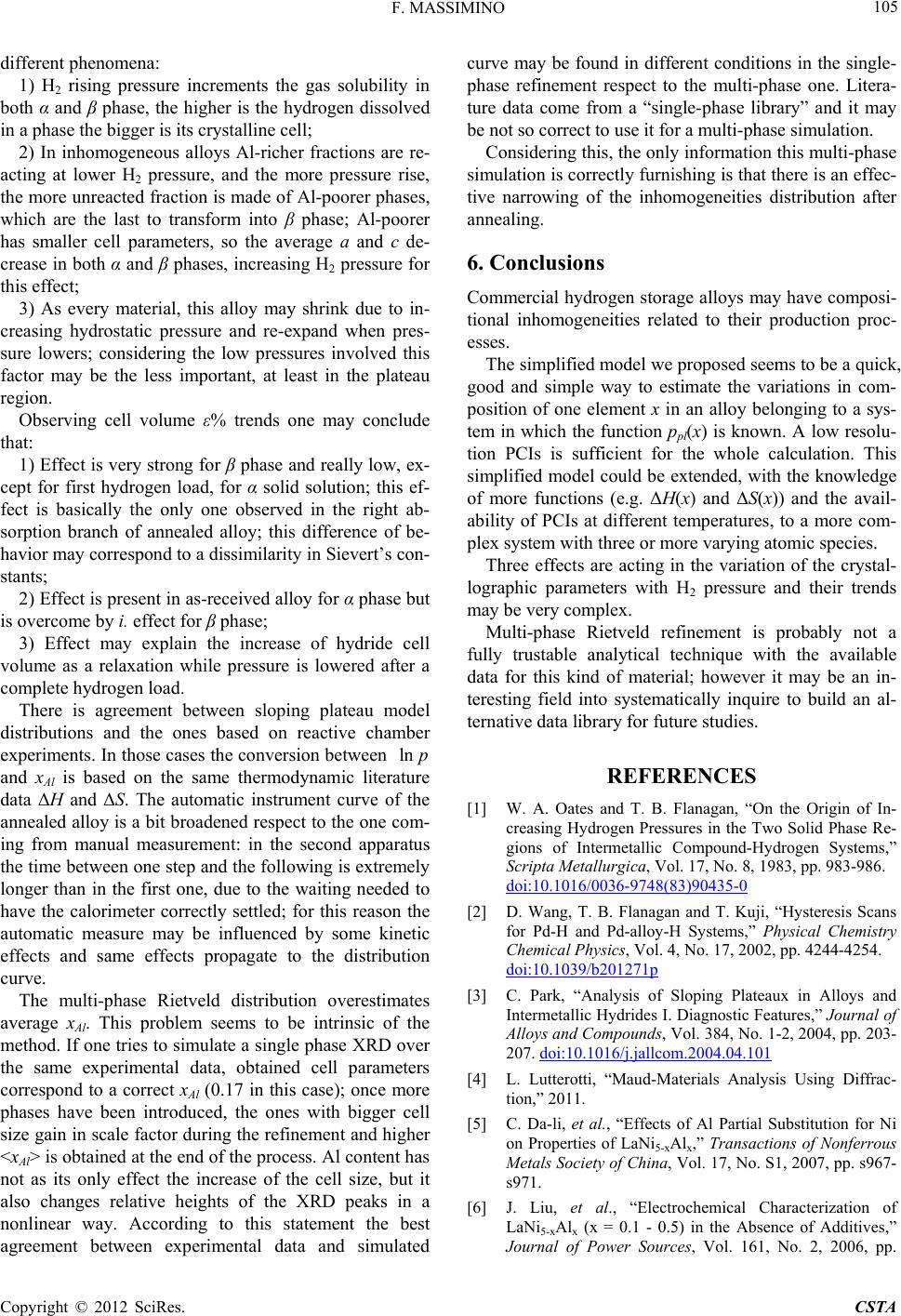
F. MASSIMINO 105
different phenomena:
1) H2 rising pressure increments the gas solubility in
both α and β phase, the higher is the hydrogen dissolved
in a phase the bigger is its crystalline cell;
2) In inhomogeneous alloys Al-richer fractions are re-
acting at lower H2 pressure, and the more pressure rise,
the more unreacted fraction is made of Al-poorer phases,
which are the last to transform into β phase; Al-poorer
has smaller cell parameters, so the average a and c de-
crease in both α and β phases, increasing H2 pressure for
this effect;
3) As every material, this alloy may shrink due to in-
creasing hydrostatic pressure and re-expand when pres-
sure lowers; considering the low pressures involved this
factor may be the less important, at least in the plateau
region.
Observing cell volume ε% trends one may conclude
that:
1) Effect is very strong for β phase and really low, ex-
cept for first hydrogen load, for α solid solution; this ef-
fect is basically the only one observed in the right ab-
sorption branch of annealed alloy; this difference of be-
havior may correspond to a dissimilarity in Sievert’s con-
stants;
2) Effect is present in as-received alloy for α phase but
is overcome by i. effect for β phase;
3) Effect may explain the increase of hydride cell
volume as a relaxation while pressure is lowered after a
complete hydrogen load.
There is agreement between sloping plateau model
distributions and the ones based on reactive chamber
experiments. In those cases the conversion between
and xAl is based on the same thermodynamic literature
data ΔH and ΔS. The automatic instrument curve of the
annealed alloy is a bit broadened respect to the one com-
ing from manual measurement: in the second apparatus
the time between one step and the following is extremely
longer than in the first one, due to the waiting needed to
have the calorimeter correctly settled; for this reason the
automatic measure may be influenced by some kinetic
effects and same effects propagate to the distribution
curve.
ln p
The multi-phase Rietveld distribution overestimates
average xAl. This problem seems to be intrinsic of the
method. If one tries to simulate a single phase XRD over
the same experimental data, obtained cell parameters
correspond to a correct xAl (0.17 in this case); once more
phases have been introduced, the ones with bigger cell
size gain in scale factor during the refinement and higher
<xAl> is obtained at the end of the process. Al content has
not as its only effect the increase of the cell size, but it
also changes relative heights of the XRD peaks in a
nonlinear way. According to this statement the best
agreement between experimental data and simulated
curve may be found in different conditions in the single-
phase refinement respect to the multi-phase one. Litera-
ture data come from a “single-phase library” and it may
be not so correct to use it for a multi-phase simulation.
Considering this, the only information this multi-phase
simulation is correctly furnishing is that there is an effec-
tive narrowing of the inhomogeneities distribution after
annealing.
6. Conclusions
Commercial hydrogen storage alloys may have composi-
tional inhomogeneities related to their production proc-
esses.
The simplified model we proposed seems to be a quick,
good and simple way to estimate the variations in com-
position of one element x in an alloy belonging to a sys-
tem in which the function ppl(x) is known. A low resolu-
tion PCIs is sufficient for the whole calculation. This
simplified model could be extended, with the knowledge
of more functions (e.g. ΔΗ(x) and ΔS(x)) and the avail-
ability of PCIs at different temperatures, to a more com-
plex system with three or more varying atomic species.
Three effects are acting in the variation of the crystal-
lographic parameters with H2 pressure and their trends
may be very complex.
Multi-phase Rietveld refinement is probably not a
fully trustable analytical technique with the available
data for this kind of material; however it may be an in-
teresting field into systematically inquire to build an al-
ternative data library for future studies.
REFERENCES
[1] W. A. Oates and T. B. Flanagan, “On the Origin of In-
creasing Hydrogen Pressures in the Two Solid Phase Re-
gions of Intermetallic Compound-Hydrogen Systems,”
Scripta Metallurgica, Vol. 17, No. 8, 1983, pp. 983-986.
doi:10.1016/0036-9748(83)90435-0
[2] D. Wang, T. B. Flanagan and T. Kuji, “Hysteresis Scans
for Pd-H and Pd-alloy-H Systems,” Physical Chemistry
Chemical Physics, Vol. 4, No. 17, 2002, pp. 4244-4254.
doi:10.1039/b201271p
[3] C. Park, “Analysis of Sloping Plateaux in Alloys and
Intermetallic Hydrides I. Diagnostic Features,” Journal of
Alloys and Compounds, Vol. 384, No. 1-2, 2004, pp. 203-
207. doi:10.1016/j.jallcom.2004.04.101
[4] L. Lutterotti, “Maud-Materials Analysis Using Diffrac-
tion,” 2011.
[5] C. Da-li, et al., “Effects of Al Partial Substitution for Ni
on Properties of LaNi5-xAlx,” Transactions of Nonferrous
Metals Society of China, Vol. 17, No. S1, 2007, pp. s967-
s971.
[6] J. Liu, et al., “Electrochemical Characterization of
LaNi5-xAlx (x = 0.1 - 0.5) in the Absence of Additives,”
Journal of Power Sources, Vol. 161, No. 2, 2006, pp.
Copyright © 2012 SciRes. CSTA